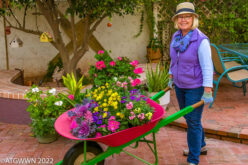Furnace Creek Inn, Death Valley, CA
 As the summer heat wears on I wonder if I might feel cooler thinking of places that are hotter and drier than where I am. So Death Valley National Park and Furnace Creek CA spring to mind. Just the names sound hot and years of record high heat support its reputation of the hottest, driest, and lowest place in the U.S. Though Death Valley was set aside as a protected area in 1933, it didn’t become a National Park until 1994. Always curious about this fierce sounding place I was completely surprised by the flowers of the park and the oasis garden at the Furnace Creek Inn. Travel really does break apart our preconceived notions of a place.
As the summer heat wears on I wonder if I might feel cooler thinking of places that are hotter and drier than where I am. So Death Valley National Park and Furnace Creek CA spring to mind. Just the names sound hot and years of record high heat support its reputation of the hottest, driest, and lowest place in the U.S. Though Death Valley was set aside as a protected area in 1933, it didn’t become a National Park until 1994. Always curious about this fierce sounding place I was completely surprised by the flowers of the park and the oasis garden at the Furnace Creek Inn. Travel really does break apart our preconceived notions of a place.
Death Valley NP encompasses 3.4 million acres so few visitors will see it all. Though as you drive in and the view opens up for miles and miles, you think you must be seeing the entire park stretched out ahead. Sand, salt and small shrubs dominate. There aren’t many trees blocking the view. In fact shade is truly a fleeting aspect of this place. Joshua trees and Bristol Cone pines aren’t known for providing a vast canopy of cooling. There is a expansiveness in this place that made me long for an edge to hold on to and from which to frame my view.
My visit was in April before the high heat sets in and just in time for a display of wildflowers ever so small in distinct patches along the road. Driving the paved highway can move you quickly through the miles of openness. Seeing the flowers requires you to slowdown, pullover and stop. Then on plant stems rising as little as six inches you begin to see spots of color. One of the wildflowers is named the “desert five-spot” which only blooms in the spring after rare winter rain.

In a long view you can see wildflowers, salt flats 200 ft below sea level, and snow topped mountains rising over 14,000 feet high.

Furnace Creek is a spring and water generates life. When that life is influenced by a 1920‘s Hollywood oasis idea it creates Furnace Creek Inn as it stands today. After miles of desert flat a seeming mirage rises in the midst of a searing dry heat. The Spanish Mission architecture and design was the work of a Los Angeles architect Albert Martin and landscape architect Daniel Hull. I found my delight behind the Inn in the shade of date palm trees, flowering shrubs of bougainvillea, oleander, and sacred datura. The trees surround ponds of moss covered rocks. The cooling effect is immediate and the surprise of the oasis of green is long lasting.

The spring waterfalls down to the ponds creating a comforting sound. Sitting on a shaded bench you look out over the dry sandy miles beyond. You do believe you have to be dreaming.
A swimming pool of spring fed non chlorinated water is gleaming and the idea of Hollywood legends floating about in the pool late at night admiring the stars is startlingly real. The movie runs in your head as you wander about this seemingly movie set oasis. Yet it really exists – gardens, water, shade and at night a spectacularly dark sky.

Facing west, the mission-style inn has red tiled roof, turquoise window frames, and adobe walls. Terraced garden spaces run uphill to the main entrance. We had lunch at the Inn and discovered that our waiter was one of the 24 year round residents (per 2010 census) of Furnace Creek Ranch. He assured me that his tomato plants produced beautifully.
The vast size and diversity of Death Valley NP prevents adequate description of the plant life of the area. The brochure boasts of over 1000 kinds of plants growing in the park. While the garden oasis of Furnace Creek is a familiar palate of plants for southwest gardeners, the lush green space created exceeded my expectations. I look for gardens everywhere I travel and I found one even in the hottest, driest and lowest spot in the United States.
originally published in Maricopa County Master Gardener newsletter, Roots & Shoots, http://cals.arizona.edu/maricopa/garden/mgcentral/uploads/Sep11.pdf
